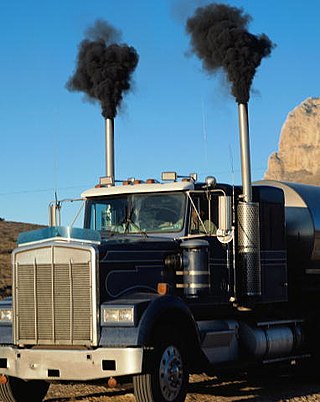
Pollution is the introduction of contaminants into the natural environment that cause adverse change. Pollution can take the form of any substance or energy. Pollutants, the components of pollution, can be either foreign substances/energies or naturally occurring contaminants.

Smog, or smoke fog, is a type of intense air pollution. The word "smog" was coined in the early 20th century, and is a portmanteau of the words smoke and fog to refer to smoky fog due to its opacity, and odor. The word was then intended to refer to what was sometimes known as pea soup fog, a familiar and serious problem in London from the 19th century to the mid-20th century, where it was commonly known as a London particular or London fog. This kind of visible air pollution is composed of nitrogen oxides, sulfur oxide, ozone, smoke and other particulates. Man-made smog is derived from coal combustion emissions, vehicular emissions, industrial emissions, forest and agricultural fires and photochemical reactions of these emissions.

Environmental science is an interdisciplinary academic field that integrates physics, biology, and geography to the study of the environment, and the solution of environmental problems. Environmental science emerged from the fields of natural history and medicine during the Enlightenment. Today it provides an integrated, quantitative, and interdisciplinary approach to the study of environmental systems.

The Great Smog of London, or Great Smog of 1952, was a severe air pollution event that affected London, England, in December 1952. A period of unusually cold weather, combined with an anticyclone and windless conditions, collected airborne pollutants—mostly arising from the use of coal—to form a thick layer of smog over the city. It lasted from Friday 5 December to Tuesday 9 December 1952, then dispersed quickly when the weather changed.

Arnold Orville Beckman was an American chemist, inventor, investor, and philanthropist. While a professor at California Institute of Technology, he founded Beckman Instruments based on his 1934 invention of the pH meter, a device for measuring acidity, later considered to have "revolutionized the study of chemistry and biology". He also developed the DU spectrophotometer, "probably the most important instrument ever developed towards the advancement of bioscience". Beckman funded the Shockley Semiconductor Laboratory, the first silicon transistor company in California, thus giving rise to Silicon Valley. After retirement, he and his wife Mabel (1900–1989) were numbered among the top philanthropists in the United States.

Exhaust gas or flue gas is emitted as a result of the combustion of fuels such as natural gas, gasoline (petrol), diesel fuel, fuel oil, biodiesel blends, or coal. According to the type of engine, it is discharged into the atmosphere through an exhaust pipe, flue gas stack, or propelling nozzle. It often disperses downwind in a pattern called an exhaust plume.

Environmental technology (envirotech) or green technology (greentech), also known as clean technology (cleantech), is the application of one or more of environmental science, green chemistry, environmental monitoring and electronic devices to monitor, model and conserve the natural environment and resources, and to curb the negative impacts of human involvement.

The Clean Air Act 1956 was an Act of the Parliament of the United Kingdom enacted principally in response to London's Great Smog of 1952. It was sponsored by the Ministry of Housing and Local Government in England and the Department of Health for Scotland, and was in effect until 1993.

LEAD
In atmospheric chemistry, NOx is shorthand for nitric oxide and nitrogen dioxide, the nitrogen oxides that are most relevant for air pollution. These gases contribute to the formation of smog and acid rain, as well as affecting tropospheric ozone.

Winfrith Atomic Energy Establishment, or AEE Winfrith, was a United Kingdom Atomic Energy Authority site near Winfrith Newburgh in Dorset. It covered an area on Winfrith Heath to the west of the village of Wool between the A352 road and the South West Main Line.

Research Councils UK, sometimes known as RCUK, was a non-departmental public body that coordinated science policy in the United Kingdom from 2002 to 2018. It was an umbrella organisation that coordinated the seven separate research councils that were responsible for funding and coordinating academic research for the arts, humanities, science and engineering. In 2018 Research Councils transitioned into UK Research and Innovation (UKRI).
The WRc Group is a company providing research and consultancy in water, waste and the environment in the United Kingdom. A government body, the Water Pollution Research Board, was set up in 1927 and was merged in 1974 with the Water Research Association and the Water Resources Board to form the Water Research Centre, which was controlled by, and undertook research for, the regional water authorities; the organisation was privatised in 1989 as WRc plc, then acquired by RSK Group in 2020.

Air pollution is the contamination of air due to the presence of substances in the atmosphere that are harmful to the health of humans and other living beings, or cause damage to the climate or to materials. It is also the contamination of indoor or outdoor surrounding either by chemical activities, physical or biological agents that alters the natural features of the atmosphere. There are many different types of air pollutants, such as gases, particulates, and biological molecules. Air pollution can cause diseases, allergies, and even death to humans; it can also cause harm to other living organisms such as animals and crops, and may damage the natural environment or built environment. Air pollution can be caused by both human activities and natural phenomena.
Arie Jan Haagen-Smit was a Dutch chemist. He is best known for linking the smog in Southern California to automobiles and is therefore known by many as the "father" of air pollution control. After serving as an original board member of the Motor Vehicle Pollution Control Board, formed in 1960 to combat the smog, Dr. Haagen-Smit became the California Air Resources Board's first chairman in 1968. Shortly before his death in Pasadena, California of lung cancer, the Air Resources Board's El Monte Laboratory was named after him.

The Indian Institute of Petroleum (IIP), established in 1960, is one of the 37 constituent laboratories of the Council of Scientific and Industrial Research (CSIR), dedicated to R&D in the hydrocarbon sector.
John Hersh Seinfeld is an American chemical engineer and pioneering expert in atmospheric science. His research on air pollution has influenced public policy, and he developed the first mathematical model of air quality, which has influenced air pollution tracking and research across the United States. He has spent his career at the California Institute of Technology, where he is currently the Louis E. Nohl Professor of Chemical Engineering.
The Department of Scientific and Industrial Research was a department of the British Government responsible for the organisation, development, and encouragement of scientific and industrial research. At the outbreak of the First World War "Britain found ... it was dangerously dependent on enemy industries". At the request of the Board of Trade, the Board of Education prepared a White Paper under the chairmanship of Sir William McCormick. The DSIR was set up to fill the roles that the White Paper specified: "to finance worthy research proposals, to award research fellowships and studentships [in universities], and to encourage the development of research associations in private industry and research facilities in university science departments. [It] rapidly assumed a key role in coordinating government aid to university research. It maintained these roles until 1965. The annual budget during its first year, 1915, was £1,000,000.
Martin Lloyd Williams was a Welsh chemist and environmental scientist who made important contributions to the science of air pollution and its incorporation into public policy in the United Kingdom. Williams was one of the first scientists to recognize the harmful health effects of ground-level ozone, in papers published in Nature in the mid-1970s, and one of the first to study vehicle emissions in the real world. He also established the first systematic programme to produce inventories of UK national air pollution emissions.














